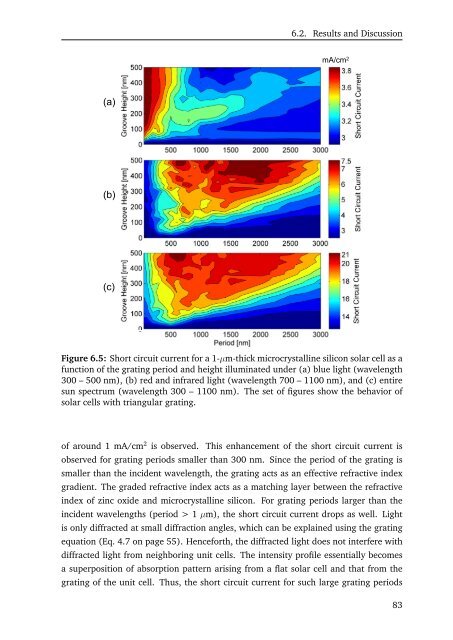Rahul Dewan - Jacobs University
Rahul Dewan - Jacobs University
Rahul Dewan - Jacobs University
Create successful ePaper yourself
Turn your PDF publications into a flip-book with our unique Google optimized e-Paper software.
6.2. Results and Discussion<br />
mA/cm 2<br />
(a)<br />
(b)<br />
(c)<br />
Figure 6.5: Short circuit current for a 1-µm-thick microcrystalline silicon solar cell as a<br />
function of the grating period and height illuminated under (a) blue light (wavelength<br />
300 – 500 nm), (b) red and infrared light (wavelength 700 – 1100 nm), and (c) entire<br />
sun spectrum (wavelength 300 – 1100 nm). The set of figures show the behavior of<br />
solar cells with triangular grating.<br />
of around 1 mA/cm 2 is observed. This enhancement of the short circuit current is<br />
observed for grating periods smaller than 300 nm. Since the period of the grating is<br />
smaller than the incident wavelength, the grating acts as an effective refractive index<br />
gradient. The graded refractive index acts as a matching layer between the refractive<br />
index of zinc oxide and microcrystalline silicon. For grating periods larger than the<br />
incident wavelengths (period > 1 µm), the short circuit current drops as well. Light<br />
is only diffracted at small diffraction angles, which can be explained using the grating<br />
equation (Eq. 4.7 on page 55). Henceforth, the diffracted light does not interfere with<br />
diffracted light from neighboring unit cells. The intensity profile essentially becomes<br />
a superposition of absorption pattern arising from a flat solar cell and that from the<br />
grating of the unit cell. Thus, the short circuit current for such large grating periods<br />
83

















